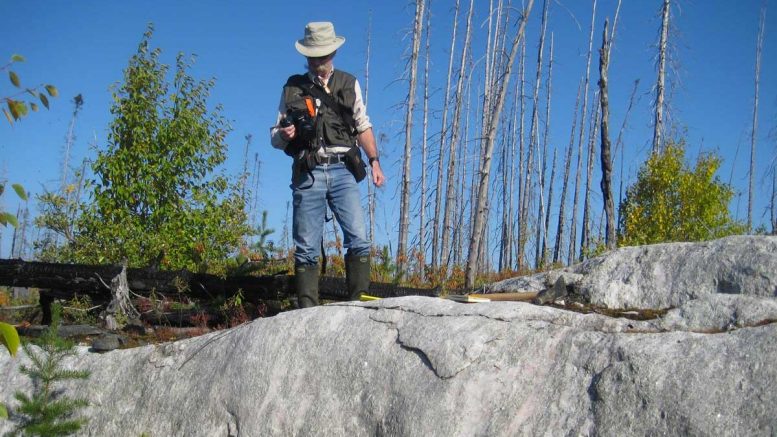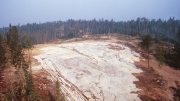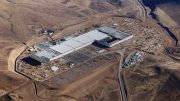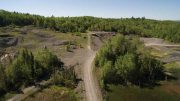Since Nemaska Lithium (TSX: NMX; US-OTC: NMKEF) completed an updated feasibility study in April last year on its Whabouchi hard-rock lithium deposit in Quebec and the chemical plant it will build to make lithium hydroxide and lithium carbonate, the price for the two lithium chemicals used in making lithium-ion batteries has surged.
The feasibility study used a conservative price of US$7,000 per tonne for lithium carbonate, which in May 2017 was selling at US$12,000 per tonne, up 71%. For lithium hydroxide, the feasibility study used US$9,500 per tonne, but last month it was priced at US$16,000 per tonne, in a 68% increase.
Assuming production costs outlined in the study of US$2,753 per tonne for lithium carbonate and US$2,154 per tonne for lithium hydroxide remain constant, the company says it would be the world’s lowest-cost producer of lithium hydroxide from either brine or hard-rock lithium deposits, and the lowest-cost producer of lithium carbonate from a hard-rock lithium deposit.
“We are in very good shape,” Guy Bourassa, Nemaska Lithium’s president and CEO, says in an interview, noting that management has already signed off-take agreements with Johnson Matthey (LON: JMAT) and FMC (NYSE: FMC) for half of the company’s lithium carbonate equivalent, in contracts running three to five years long.

Core racks at Nemaska Lithium’s Whabouchi lithium project, 300 km northwest of Chibougamau. Credit: Nemaska Lithium.
“We easily could have signed other off-take agreements that would have allowed us to sell more than 100% of our capacity, but we assumed, and were quite right in our assumption, that 50% of take-or-pay off-take agreements would be enough to justify 60–65% of the debt in the project financing,” Bourassa adds. “And the discussions we are having with lenders at the moment prove us right. They are satisfied with the off-take agreements that we have.”
Nemaska Lithium is negotiating with two potential lenders, one a natural resources bank and the other a group of private lenders in the U.S., Bourassa says.
“We’re doing these discussions in parallel and the first one that comes to the fore is the one who gets it,” he says. “There isn’t room for both — they are capable of taking it all. It’s just a question of timing.”
The plan calls for shipping spodumene concentrate produced at Whabouchi to a hydromet plant the company will build in Shawinigan, Que., where it will go from concentrate to high-purity lithium hydroxide and lithium carbonate, using methods the company has developed and patented.
Nemaska’s electrolysis technology eliminates the need to use soda ash as a reagent in producing lithium carbonate. And by using electrolysis, Nemaska Lithium’s main input cost is electricity, which in Quebec is cost effective and predictable, the company says.
The company plans to take a 6% spodumene concentrate produced from its Whabouchi mine and process it into lithium sulphate. After several stages of impurity removals, the lithium sulphate solution will be transformed through electrolysis into a high-purity liquid lithium hydroxide. The lithium hydroxide is then transformed into a lithium monohydrate (solid), or bubbled with carbon dioxide and changed into lithium carbonate.
The company chose Shawinigan, 140 km west of Quebec City, because of its history of industrial development, mainly in the forestry, aluminum and chemical sectors. The area emerged as an industrial centre because operators could exploit the hydroelectric potential of Shawinigan Falls.
Since the 1960s, however, there has been a decline in the city’s economy, as many industries have stopped. The Belgo pulp and paper mill closed in 2008, Alcan’s aluminum plant closed in 2013 and the Laurentide pulp and paper mill closed in 2014.
Nemaska Lithium is already using the Shawinigan site for its 610-tonne-per-year demonstration plant, which was built in part to show customers like Johnson Matthey — a cathode manufacturer for lithium-ion batteries — that its proprietary process could meet Johnson Matthey’s specifications.
Nemaska can then integrate any process improvements when it builds its commercial hydromet plant.
In March, Nemaska was producing spodumene concentrate using a dense media separation (DMS) modular mill at Whabouchi that processed material from a bulk sample taken from the eastern end of the main dike within the planned pit.
Between March 8 and April 2, close to 1,200 tonnes of ore was processed through the DMS plant with an average head grade of over 1.75% Li2O. The assay results received returned an average grade of 6.2% Li2O for the dense media concentrate.
Nemaska delivered the first shipment of lithium hydroxide solution — equivalent to 1.2 tonnes of lithium hydroxide monohydrate — to Johnson Matthey in April, and a second shipment in June. Both shipments met the customer’s specifications. Johnson Matthey Battery Materials uses lithium hydroxide to produce lithium iron phosphate cathodes.
In June the company unveiled a $50-million bought-deal financing with a syndicate of underwriters led by National Bank Financial. The proceeds will help advance construction of the mine, spodumene concentrator and the hydromet plant.
Bourassa notes that there is no rush to build the mine because it doesn’t expect to commission the hydromet plant until the second half of 2018, and commercial production likely won’t begin until the first quarter of 2019. The mine will take nine months to build, and construction could begin as early as September.
Initial capex for the project is estimated at $549 million — $210 million for the mine and $339 million for the chemical plants — and the 2016 feasibility study forecasts this sum can be paid off in under two and a half years. Overall the project has an after-tax net present value of $1.2 billion at an 8% discount rate, and an anticipated 30.3% post-tax internal rate of return.
Over a 26-year mine life, Nemaska expects to produce 5.5 million tonnes of spodumene concentrate. The company plans to convert the concentrate into 714,000 tonnes of battery-grade lithium hydroxide and 84,000 tonnes of battery grade lithium carbonate, for total life-of-mine revenue of $9.2 billion.
On an annual basis, 213,000 tonnes of concentrate would be converted into 27,500 tonnes of lithium hydroxide and 3,245 tonnes of lithium carbonate for revenue of $354 million a year.
Whabouchi would be mined as an open pit for the first 20 years based on in-pit proven and probable reserves of 20 million tonnes of 1.53% lithium oxide (the pit would developed to a maximum depth of 190 metres), and six years as an underground mine, accessed by a ramp in the open pit, based on proven and probable reserves of 7.3 million tonnes grading 1.28% lithium oxide. The underground development would extend 90 metres below the pit bottom.
The open pit would be mined at a rate of 2,740 tonnes per day and the underground at 3,340 tonnes per day.
The Quebec government is Nemaska Lithium’s largest shareholder, through Ressources Québec’s holding of 29.4 million shares.
At press time, Nemaska Lithium’s shares were trading at $1.02 in a 52-week range of 89¢ to $1.60.
The company has 329 million shares outstanding for a $336-million market capitalization.






Be the first to comment on "Nemaska Lithium’s Whabouchi could produce for 26 years"